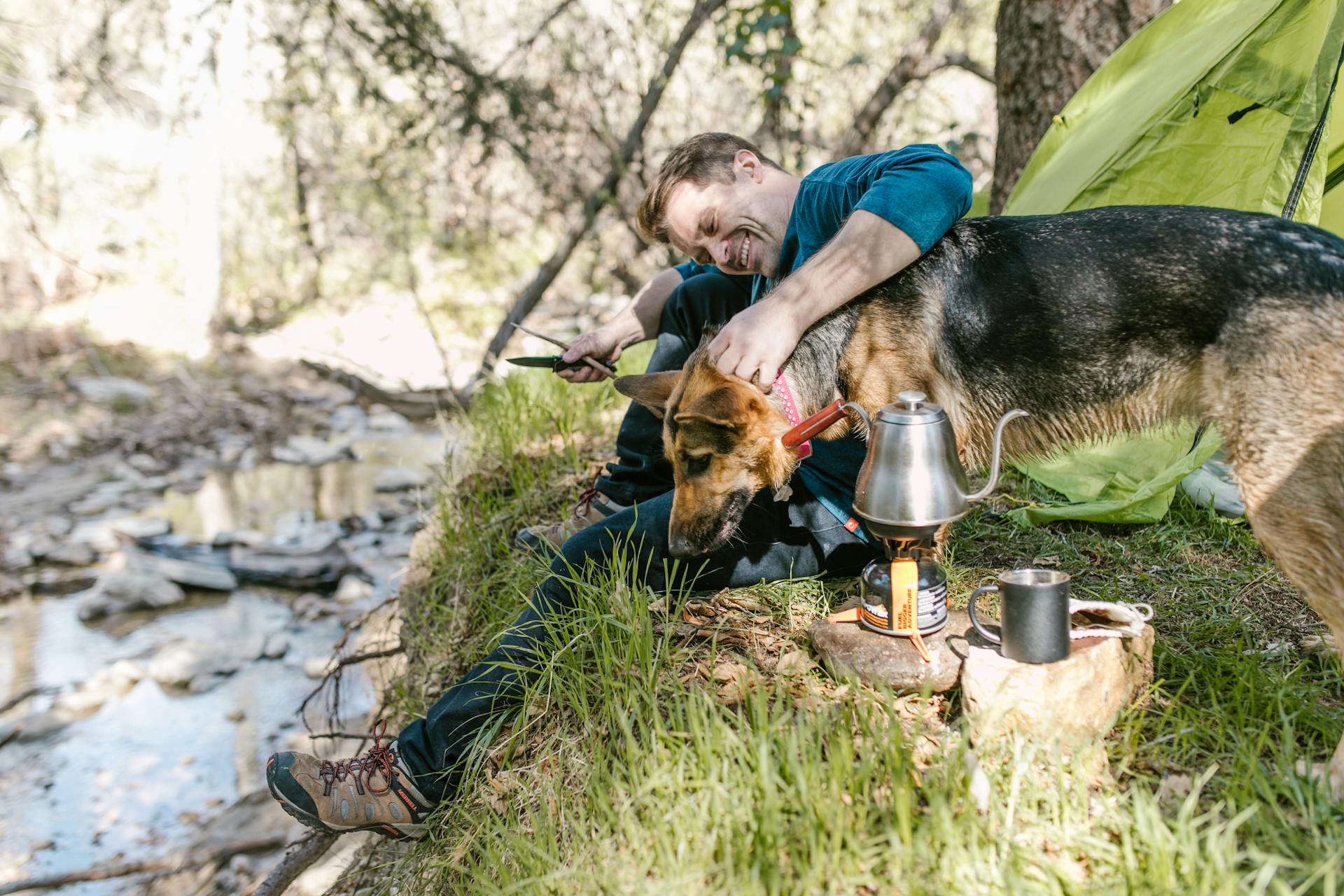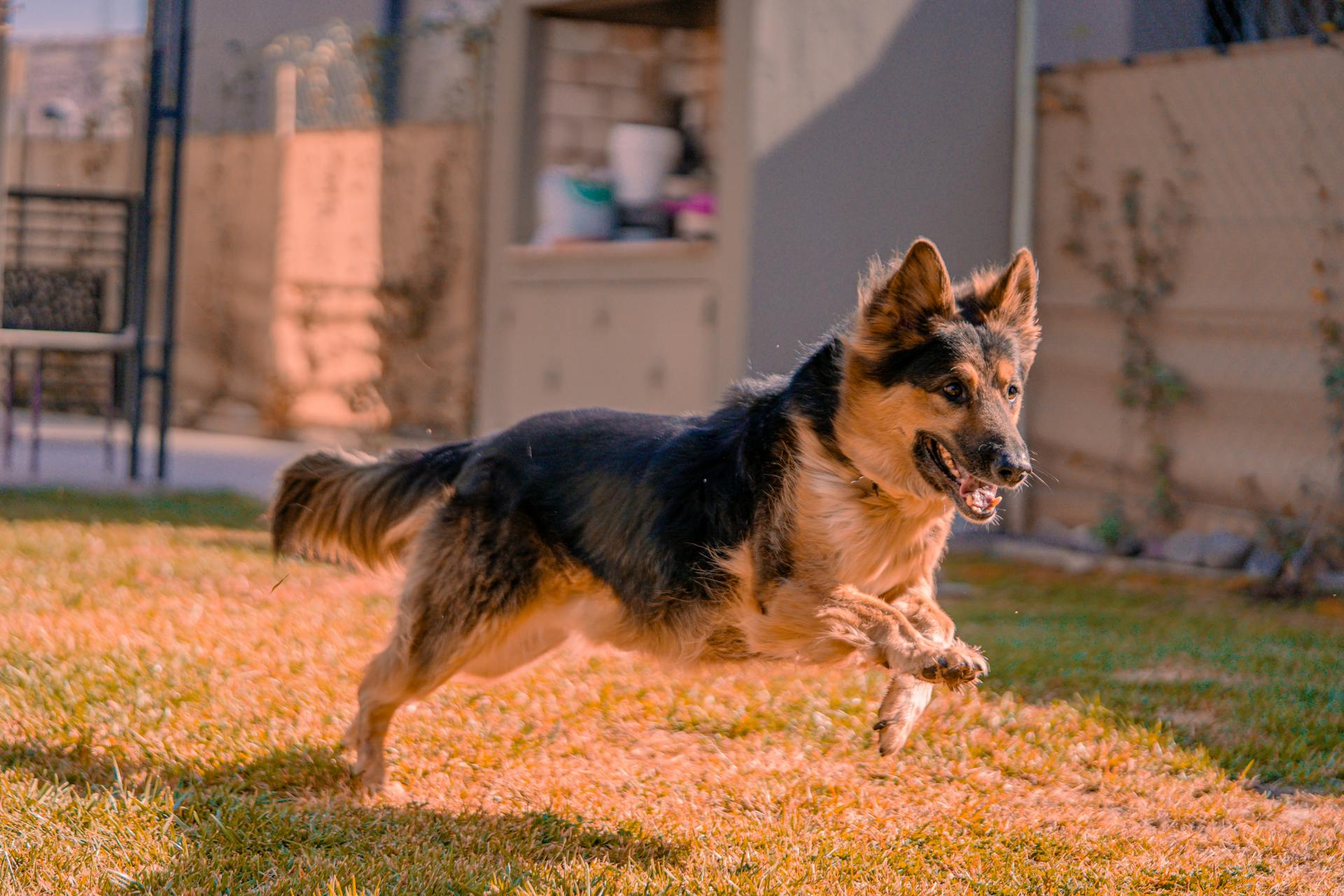
Training your GSD guard dog requires a combination of socialization, obedience, and protection skills. Socialization is key to developing a confident and calm dog.
A well-socialized GSD is less likely to become aggressive or fearful in new situations. This is especially important for a guard dog, as they need to be able to distinguish between a threat and a harmless person.
Basic obedience training is essential for any dog, but it's especially crucial for a GSD guard dog. This includes commands like "sit", "stay", and "come", which help establish clear communication and boundaries.
By starting with basic obedience training and gradually increasing the level of difficulty, you can build your GSD's confidence and competence.
Related reading: Dog Training Basic Obedience Lesson Plan
Getting Started
Getting started with GSD guard dog training requires expert knowledge from trainers, multiple handlers, and assistants.
Training a protection dog is a large time and financial commitment, so you need to bear this in mind when initiating this type of complex training.
To succeed, you'll need to obtain the assistance of a professional organization and trainers equipped to provide the necessary resources.
Your dog will need to be well socialized and have good obedience and manners prior to training, which is a crucial foundation for guard training.
Protection dogs need lots of exercise to maintain peak physical performance, so be prepared to provide regular physical activity.
Starting early is key, and for German Shepherds, this means beginning training around 8-10 weeks old, when they're like little sponges eager to soak up knowledge and skills.
At this young age, you can teach them basic commands and guide their natural curiosity and energy in the right direction, helping them become well-behaved and disciplined from the get-go.
Training Methods
Training your GSD guard dog requires a combination of consistency, patience, and positive reinforcement.
Start with basic obedience training, such as "sit", "stay", and "come", which can be taught using treats and praise.
Socialization is crucial, so expose your GSD to various environments, people, and other animals from an early age.
For guard dog training, it's essential to teach your GSD to respond to commands in distracting situations, such as with loud noises or other dogs present.
Use high-value rewards, like treats and praise, to motivate your GSD during training.
Related reading: Gsd Crate Training
Commands and Techniques
In guard dog training, commands and techniques are crucial for effective communication with your German Shepherd. You'll need to teach your dog a range of commands, including "attack" and "stop", to help them understand what's expected of them in various situations.
To train the "attack" command, use a word in a foreign language, such as Russian, German, or Japanese, to avoid accidentally using it. This will help your dog associate the command with a specific action.
Protective gear is essential for training the "attack" command to prevent your dog from biting you or an assistant. Start by encouraging your dog to bite a mitt or padded sleeve as if you were playing, and reward them with praise and treats when they do so.
On a similar theme: Do Dog Diapers Help with Potty Training
Obedience training is the foundation of guard dog training, and it's essential to teach your German Shepherd basic commands like "sit", "stay", and "heel". This will help them develop a strong bond with you and respond promptly to commands in potentially dangerous situations.
Positive reinforcement is a key technique in guard dog training, using rewards and praise to motivate your dog and reinforce desirable behaviors. This will help your dog associate training with positivity and make them more eager to learn and please you.
Scenario-based training is critical in preparing your German Shepherd for real-life situations, such as responding to strangers approaching your property or dealing with simulated intruders. This type of training will help your dog develop the skills and confidence to handle various security situations effectively.
Here are the essential commands and techniques for guard dog training:
- Attack command: Use a word in a foreign language, such as Russian, German, or Japanese.
- Stop command: Practice repeatedly in different scenarios to ensure your dog learns to obey the command to break off the attack.
- Obedience training: Teach basic commands like "sit", "stay", and "heel" to develop a strong bond with your dog.
- Positive reinforcement: Use rewards and praise to motivate your dog and reinforce desirable behaviors.
- Scenario-based training: Prepare your dog for real-life situations, such as responding to strangers or dealing with simulated intruders.
Practice and Improvement
Practice is key to mastering the attack and recall commands. You'll need to have an assistant in full protective gear practice with your dog in various situations.
To ensure your dog understands the commands in many situations, practice them a few times in different scenarios. This will help them stay on their game and not forget the commands.
Regular practice is essential, even after your dog has mastered the command. This will keep them sharp and ready to respond to emerging security challenges.
Consider reading: Does Neutering Dog Help with Aggression
Continuous Learning
Continuous learning is like ongoing professional development for a specialized role. It involves regularly updating and refining your German Shepherd's skills and knowledge.
To keep your dog effective and adaptable, you should practice the recall command until they have mastered it. This makes getting your dog back after issuing the attack command much easier.
Continuous learning ensures your dog remains a reliable and vigilant protector over time. It's an investment in their effectiveness and your peace of mind.
You'll want to practice the recall command in many situations, not just in one specific scenario. This will help your dog understand the commands in various contexts.
Just like a soldier undergoes regular training exercises, your guard dog needs continuous learning to stay sharp and ready to respond to emerging security challenges.
Curious to learn more? Check out: What Is Recall in Dog Training
At What Age Should Be Trained?
German Shepherds are best commenced with training at a tender age of around 8-10 weeks old. This is because their minds are highly receptive during this period, making it an optimal time to start laying the foundation for future guard dog training.
The puppy stage is crucial for developing essential guarding skills, and it's vital to approach this training in a gradual, phased manner to ensure the puppy is not overwhelmed.
German Shepherds who undergo formal training from a young age are observed to be better disciplined, more responsive, and exhibit a well-rounded protective instinct, proving to be efficient guardians.
Take a look at this: Dog Training Age
Socialization
Socialization is a vital step in helping your German Shepherd get accustomed to different people, places, and situations, which builds their confidence and prevents anxiety or aggression in unfamiliar settings.
It's like teaching them the 'language' of the world around them, helping them understand and interpret various stimuli correctly. A well-socialized German Shepherd can distinguish between normal and potentially threatening situations, ensuring they react appropriately when guarding your home or family.

Socialization training at a young age helps prevent the development of fear-based behaviors, promoting a calm and rational response to new experiences. This lays a foundation for them to be balanced, vigilant protectors without being unnecessarily aggressive.
A well-socialized German Shepherd can be a trustworthy guardian and a friendly, well-adjusted family member.
Physical Conditioning
Physical conditioning is akin to setting a person up with a regular fitness regimen, ensuring they remain healthy and agile. For a German Shepherd, this step in the training process is vital, as it helps build up their stamina and strength, necessary attributes for a guard dog that may need to spring into action at any moment.
Regular exercise and activities designed to test and build their physical capabilities are essential. This helps them stay in prime condition, able to patrol your property, and easily keep you safe.
Much like a person training for a marathon, physical conditioning for your German Shepherd is about building endurance, muscle strength, and overall physical health. This step ensures that your dog is ready to protect you and promotes their general well-being, ensuring a happier, healthier life in the long run.
Here's an interesting read: Classical Conditioning Dog Training
Characteristics and Breeds
Herding breeds like Great Pyrenees, Anatolian Shepherds, and Komondors are naturally inclined to protect their flock, making them excellent watch dogs.
Many of these breeds are wary of strangers and will not hesitate to bark to alert their family. They're also likely to take action if necessary.
Terriers, on the other hand, are known for their alert barking, although they're less likely to follow through with biting.
For your interest: Cardiac Alert Dog Training
Characteristics of Competence
A good guard dog is more than just a fierce barker; it's a loyal companion that can provide peace of mind for you and your family. German Shepherds are renowned for their natural protective instincts, which are ingrained through generations of selective breeding and training.
Their keen senses and agility make them a formidable deterrent to potential intruders. A German Shepherd's mere presence can be a strong deterrent to potential intruders, most burglars prefer to avoid homes with vigilant and vocal dogs.
Guard dogs can be trained to respond to commands and differentiate between real threats and false alarms. A well-trained German Shepherd can be an excellent guardian, showcasing loyalty, courage, and intelligence.
Some breeds, like the European German Shepherd, are bred specifically for their guarding capabilities. The European German Shepherd is the most universal working dog bred in the world today, with a strong sense of duty, often being alert and cautious around strangers while showcasing affection and a protective demeanor towards their family members.
Other breeds, such as the Great Pyrenees, Anatolian Shepherds, and Komondors, are also known for their guarding abilities. These breeds are naturally inclined to protect their flock or family, and with proper training, they can become top-notch guard dogs.
Here are some key characteristics of a competent guard dog:
- Confidence: A good guard dog exudes confidence and courageousness, making it a formidable deterrent to potential intruders.
- Loyalty: A loyal companion that will defend its family and territory at all costs.
- Intelligence: A smart dog that can learn complex protection techniques and respond to commands.
- Agility: A agile dog that can quickly respond to potential threats.
- Training: A dog that has received proper training and socialization to respond to various situations.
These characteristics, combined with proper training and socialization, make a German Shepherd an excellent choice for a family guard dog.
Sensory

Sensory training is like sharpening a guard's surveillance skills, teaching your German Shepherd to use their keen senses to be vigilant and responsive.
Dogs have an incredible sense of smell and acute hearing, and by honing these abilities, you're essentially giving them superpowers that can detect intruders or unusual sounds and scents long before a human could.
Sensory training is like fine-tuning a finely-tuned instrument, ensuring that your dog knows how to respond to various scents and sounds.
It's like giving them extra eyes and ears, making them highly effective in guarding your home or property.
By teaching your dog to recognize and react appropriately to unusual scents and sounds, you're enhancing their natural surveillance skills, turning them into a vigilant and proactive protector.
Related reading: Teaching Dog Obedience
Protective Instinct and Training
German Shepherds are naturally predisposed to protect their owners, thanks to their innate loyalty and vigilant disposition, ingrained through generations of selective breeding and training. This trait is not universal, however, and they need proper training to become effective protectors.
A German Shepherd's propensity to protect stems from a deep-seated loyalty and keen senses. Historically, these dogs have been bred for various protective roles, including herding livestock, where their natural inclination to safeguard comes into play.
To tap into this natural protective instinct, German Shepherds need focused, professional protection training. This specialized training fine-tunes their innate capabilities, teaching them to react appropriately to various situations and to follow commands promptly and accurately.
German Shepherds tend to become more protective as they age, progressively refining their instincts with growth and, potentially, specialized training. As they mature, they develop a more refined protective instinct, making them even more vigilant and attuned to their surroundings.
Here are some signs that your German Shepherd is protective of you:
- Alertness: Your dog is consistently alert and aware of their surroundings, especially when you are present.
- Standing Between: They position themselves between you and perceived threats as a physical barrier.
- Barking or Growling: They may bark, growl, or exhibit vocal warnings when strangers approach you or your property.
- Attachment: German Shepherds often form strong attachments to their owners, seeking proximity and showing affection.
- Watchfulness: They maintain a watchful eye on you, even in relaxed situations.
- Protective Stance: Your dog may assume a protective posture, with raised ears, erect tail, and focused gaze when sensing a potential threat.
- Defensive Actions: In extreme situations, they might take defensive actions to shield you.
Professional protection dog training is advisable if you intend to maximize your German Shepherd's protective capabilities. Trained German Shepherds exhibit these traits and learn to respond to commands effectively, differentiating between genuine threats and benign situations, ensuring your safety while maintaining discipline and control.
Frequently Asked Questions
At what age does a German Shepherd start guarding?
German Shepherd puppies typically start guarding around 10-16 months of age, with females becoming protective earlier than males. This age range marks the beginning of their protective instincts, but proper training and socialization are still crucial for responsible guarding behavior.
How much does it cost to train a German Shepherd to be a guard dog?
Prices for elite guard dogs start at $30,000 for Level 1, $45,000 for Level 2, and $65,000 for Level 3, depending on the level of training and title. Training a German Shepherd to be a guard dog can be a significant investment, but the cost varies based on the level of expertise and certification.
How do I stop my German Shepherd from being overprotective?
To address overprotectiveness in your German Shepherd, establish clear boundaries and provide consistent training from an early age, focusing on gentle yet firm guidance. By doing so, you can help your dog develop a balanced temperament and reduce overprotective behaviors.
Sources
- https://wagwalking.com/training/train-a-german-shepherd-to-protect
- https://www.hepper.com/how-to-train-a-german-shepherd-to-be-a-guard-dog/
- https://www.dog-obedience-training-review.com/guard-dog-training-and-selection.html
- https://harrisonk9.com/family-protection/
- https://gsdcolony.com/blogs/news/at-what-age-does-a-german-shepherd-start-guarding
Featured Images: pexels.com


